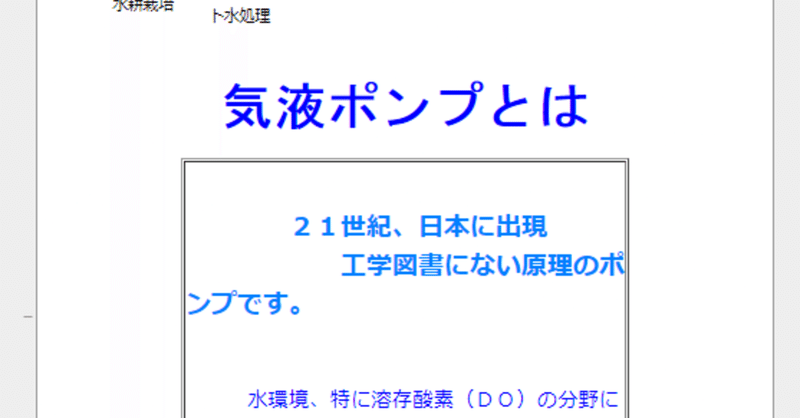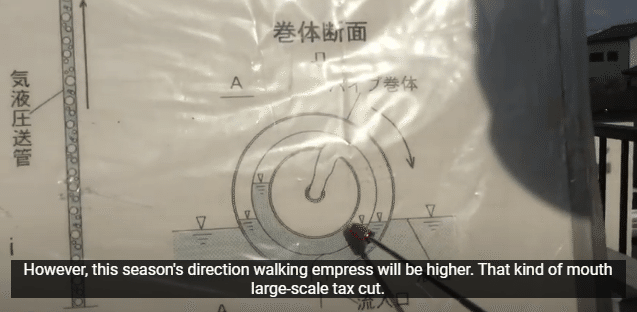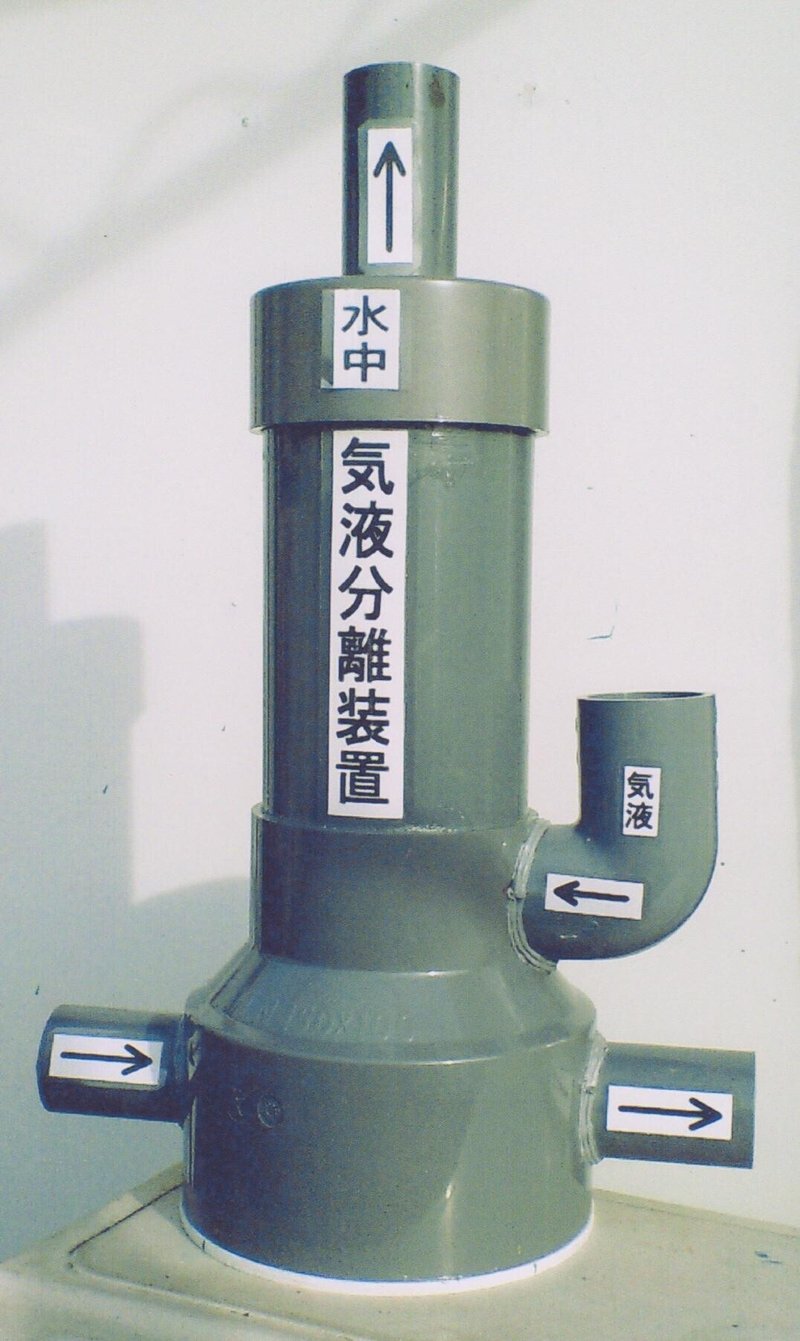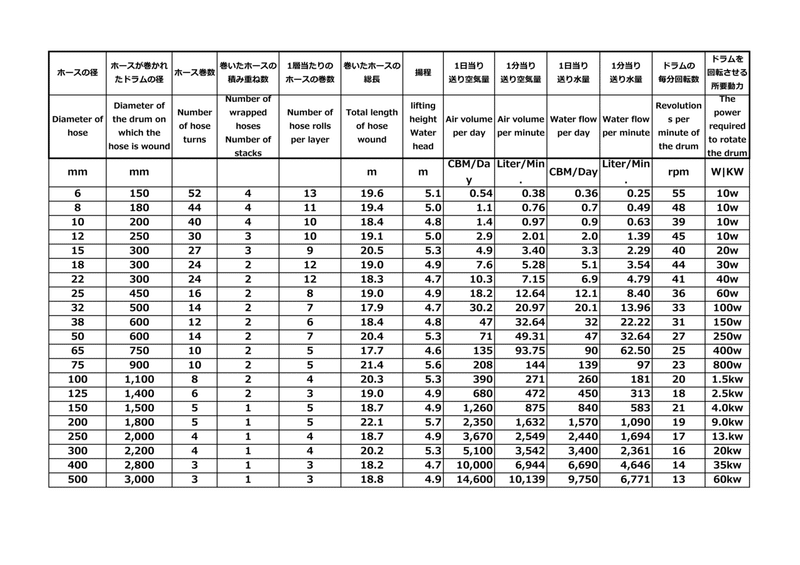
気液ポンプ®・空気と水の混相流ポンプ : インターネット上ではWater wheel pump と呼ばれているポンプ。 KIEKI PUMP|Air and Water Multi-phase Flow Pump : A pump known on the Internet as a water wheel pump.
2021年6月1日 | June 1,2021
..... 概念説明 | Abstract .....
開発者が意図したこのポンプの目的は、水底への溶存酸素飽和水の循環です。下図は開発者がつくったそれについてのスケッチです。
The purpose of this pump, as intended by the developer, is to circulate water saturated with dissolved oxygen to the bottom of the water. The figure below is a sketch of it made by the developer.

空気と水の混相流ポンプ Air and Water Multi-phase Flow Pump の稼働実例。写真と動画。下のURLをクリックしてください。examples of operation an Air and Water Multi-phase Flow Pump. Photos and video. Click on the URL below.
https://youtu.be/mN9iLNHGOYI?t=67
しかしこの実例と下に説明するポンプの構造は異なる。

However, the structure of the pump described below KIEKI pump is different from this actual case.
気液ポンプの開発者がその動作説明する動画と写真。下のURLをクリックしてください。Video and photos of a KIEKI pump developer explaining its operation. Click on the URL below. Please use English subtitles. However, there are some errors in the translation of the subtitles.
https://youtu.be/w-S6PuC14oM

この記事で説明する空気と水の混相流ポンプの動作の極めて大雑把な説明は A very rough description of the operation of an air-water multi-phase flow pump, as described in this article are :
園芸用ホースリールの回転軸辺りを水面に置く。
ホースの吐出口|ノズルから水と空気を取り入れる。
リールを回転する。
ホースの水栓への接続口から空気と水の混相流を吐き出す。

Place a garden hose reel around the rotating shaft on the water surface.
Take in water and air from the hose outlet/nozzle.
Rotate the reel.
Discharge air/water mixture from the hose's faucet connection.
筆者が気づいたこの記事の最重要点とそれへの見解。The most important points of this article that the author noticed and his views on them.
このポンプは溶存酸素飽和値の水をつくる可能性がある。したがって、養魚池、水耕栽培、好気排水処理などへの多大の効果が予想される。
このポンプの製作費用は安価だ。
このポンプの動力は川の流れや風車が良い。このポンプには電気モーターは不適だ。その理由は電気モーターの定格回転数からこのポンプの要求回転数に減速するには高価な減速機が要るからだ。
The most important points of this article that the author noticed and his views on them.
This pump has the potential to create water with dissolved oxygen saturation values.Therefore, it is expected to have a great effect on fishponds, hydroponics, and aerobic wastewater treatment.
This pump is inexpensive to build.
This pump can be powered by a river current or a wind turbine. An electric motor is not suitable for this pump.The reason for this is that it takes an expensive speed Reducer to reduce the speed from the rated speed of the electric motor to the required speed of this pump.
..... 概念説明終わり | End of Abstract .....
気液ポンプは下記会社の登録商標。同社はこのポンプの特許を所有している。しかし同特許は既に有効期限を過ぎているだろう。KIEKI pump is a registered trademark of the following company. The company owns the patent for this pump. However, the patent has probably expired.
http://www.rak1.jp/one/user/kieki1012/
気液工学コンサルタント(資)
・代表 吉岡 健
・〒276-0028 千葉県八千代市村上4502-12
・TEL 047-485-7583 FAX 047-750-2825
・E-mail:kieki@jcom.home.ne.jp
The meaning of KIEKI is gas and liquid. In other words, air and water.
http://www.rak1.jp/one/user/kieki1012/
KIKI Engineering Consultants, Inc.
Representative: Mr.Ken Yoshioka
ZIP:276-0028
4502-12, Murakami, Yachiyo, Chiba , Japan
TEL 047-485-7583 FAX 047-750-2825
E-mail:kieki@jcom.home.ne.jp
筆者は約10年前にこのポンプに興味をもった。そこで上記メールアドレスに問い合わせを送ったが返信はなかった。その当時はインターネット上に気液ポンプの記事は相当数あった。しかし今は下のアーカイブに見えるだけだ。したがって私は本文の記述について吉岡 健さんに未確認である。
The author became interested in this pump about 10 years ago. I sent an inquiry to the above e-mail address, but received no reply. At that time, there were quite a few articles about KIEKI pumps on the Internet. But now they are only visible in the archives below. Therefore, I have not yet confirmed the description of the text with Mr.Ken Yoshioka.
気液ポンプは持続可能な水環境維持活動への貴重な技術なのでここにアーカイブ内容を転載する。そして筆者の意見を付記する。Since KIKI pumps are a valuable technology for Sustainable water environment maintenance activities. The contents of the archive are reproduced here, and the author's opinion is added text.
http://archive.fo/YhAru この記事がアーカイブされているURL。アーカイブ日時は2013年9月15日 03:01:26 UTC。
http://archive.fo/YhAru URL where this article is archived, archived at 03:01:26 UTC on September 15, 2013.
気液ポンプとは What is a KIEKI pump?
21世紀、日本に出現 工学図書にない原理のポンプです。
It is a pump with a principle not found in engineering books.
水環境、特に溶存酸素(DO)の分野に従来にない機能を発揮します。
It has unconventional functions in the field of water environment, especially dissolved oxygen (DO).
気体と液体を混合(気液二相流)で送るポンプ。
・気液の混合比は通常、空気60%、水40%(ただし、この逆も可能)。
・送水はすべて自動的に高濃度の溶存酸素水(DO水)となる。 (通常、巻ホース延長が20mでDO濃度は飽和付近まで高まる)
A pump that pumps a mixture of gas and liquid (gas-liquid two-phase flow).
The mixing ratio of air and water is usually 60% air and 40% water (although the reverse is possible).
Normally, the DO concentration rises to near saturation when the length of the winding hose is 20 meters.
気液分離装置(気液分離器ともいう)との併用で、単独の圧力気体、圧力液体が各々確保でき、その用途は格段に広まる。
In combination with a gas-liquid separator, a single pressure gas and pressure liquid can be secured respectively. Their applications are much broader.
工学図書にない原理のポンプで、従来ポンプ回転数の1/100程度の回転数でよく無騒音・無振動的に稼動する。ブロワも、コンプレッサーも使わずに、容易に圧力気体、圧力液体が確保できる。
This pump is based on a principle not found in engineering books, and requires only 1/100 of the rotation speed of conventional pumps to operate without noise or vibration. Pressure gas and liquid can be easily secured without using a blower or compressor.
従来ポンプに必須の、羽根、歯車、ピストン、スクリュー等の内部機器は一切なく、気液ポンプは、気液の呑口から吐口まで空洞でよく、気体と液体があって初めて圧力が生まれる原理。
There are no internal devices such as blades, gears, pistons, screws, etc., which are essential for conventional pumps. A air-water pump can be hollow from the inlet to the outlet, and pressure is generated only when air and water are present.
気液ポンプの機能説明 Functional description of the KIEKI pump
・揚程は、巻ホース総延長の23〜28%。
・送量(気液量)は、ホースの口径と回転数で決まる。
・回転数は2〜60rpm(従来ポンプの約1/100)
The head is 23% to 28% of the total hose length.
The pumping volume (air-water volume) is determined by the diameter of the hose and the rotation speed.
The rotation speed is 2 to 60 rpm (about 1/100 of a conventional pump).
気液ポンプ”の原理・仕組み Principle and mechanism of the KIEKI pump.
・パイプ状の回転軸にホースを巻いた巻体を、回転軸を水平にして水面付近に設置して、回転毎にホースの一端の流入口を水面下に浸して、空気と水を交互に巻ホース内へ汲み込み、回転で巻ホース全体を通過させて圧力を生み、最終の巻ホースから回転軸の内部を経て外部へ圧送する仕組み。
(従来必要とした、羽根、歯車、ピストン、スクリュー等の内部機器は一切必要でなく、呑口から吐口まで空洞でよい)
Each time it rotates, the inlet at one end of the hose is immersed under the water surface, and air and water are alternately pumped into the hose, and the rotation causes the entire hose to pass through, creating pressure, which is then pumped from the final hose through the inside of the rotating shaft to the outside. This is the mechanism.
(There is no need for any internal equipment such as blades, gears, pistons, screws, etc., which have been required in the past, and it can be hollow from the inlet to the outlet.
従来に見ない機能的特徴 Functional features not seen before
・環境省は2013年度を目標に水質環境基準に、底層DO(下層DO)や透明度を追加する方向が見られます。
この分野・気液ポンプは従来に見ない威力を発揮します。
・気液ポンプは、閉鎖性水域の再生、 特に底層DO化、底層好気性化、底層の溶存酸素の増強には最も力を発揮します。
・魚介類の養殖に。底層の必要箇所の隅々までDO水を届けます。
・自転車を漕いで簡単揚水。一時間、1トンの水を、5メートルの高さへ。
・水耕栽培の溶存酸素水(DO水)の供給用に。
The Japanese Ministry of the Environment is planning to add bottom DO (lower DO) and transparency to the water quality environmental standards by 2013.In this field, KIEKI pumps can demonstrate unprecedented power.
The KIEKI pump is most effective in regenerating closed water bodies, especially in increasing bottom DO, bottom aerobicity, and dissolved oxygen in the bottom layer.
For fish and shellfish farming. DO water is delivered to every corner of the bottom layer where it is needed.
Easy pumping by pedaling a bicycle. One ton of water can be pumped up to a height of 5 meters in an hour.
For supplying dissolved oxygen water (DO water) for hydroponics
気液ポンプの性能説明と注意点 Performance description and cautions for KIEKI pumps
� 気体と液体を混合状態(気液二相流)で送るポンプで、およそ空気60%、水40%で送ると便利かつ効果的である。
A pump that pumps a mixture of gas-liquid two-phase flow, approximately 60% air and 40% water, is convenient and effective.
�最大揚程は、およそ、巻ホース総延長×(0.23〜0.28)となるが、安全的には、巻ホース総延長×0.25付近が適切数値と思われる。
The maximum lift is approximately 0.23 to 0.28 times the total length of the winding hose, but for safety, a value around 0.25 times the total length of the winding hose is considered appropriate.
�送気量・送水量は、巻ホースの口径と回転数で決まる。
The volume of air and water to be pumped is determined by the diameter and rotation speed of the winding hose.
�最大回転数は、巻きホースの外径に反比例し2〜60rpmの範囲が多い。
・回転数は、重力の加速度と遠心力の均衡から計算して、最大揚程の場合の、最大回転数 P≒K×42.3×√(1/D) 、Dは最外側の巻きホースの外径 Kは巻き方法等による定数。
・揚程を下げて、最大揚程の半分程度にして運転すると、その回転数は最大回転数よりも何割か増加が可能となる、従って送水量も増加する。
The maximum rotational speed is inversely proportional to the outer diameter of the hose and is usually in the range of 2 to 60 rpm.
The rotation speed is calculated from the equilibrium between the acceleration of gravity and the centrifugal force, and the maximum rotation speed at the maximum head is
P ≈ K × 42.3 × √ (1/D),
where D is the outer diameter of the outermost hose, K is a constant depending on the winding method, etc.
If the head is lowered to about half of the maximum head, the rotation speed can be increased by a fraction of the maximum speed, thus increasing the water delivery volume.
� 送水は、一般に高濃度の溶存酸素水になる。
・気液ポンプの内部を通過する水は、巻きホースの回転で自動的に高圧化する、送水は、この巻きホース内の長距離間を、ホースの内壁と摩擦しながら、高圧状態で気液混合しながら通過後に外部へ放流するため、自動的に高濃度・溶存酸素水になる。
The water pumped will generally be highly concentrated dissolved oxygen water.
The water passing through a KIEKI pump is automatically pressurized by the rotation of the hose, and the water is automatically discharged to the outside after passing through the long distances in the hose, mixing air and water under high pressure while rubbing against the inner wall of the hose.
� 気液二相流での「揚程」と「水中送気水深」での注意点 � A note on "Water head" and "Depth of water that can be pumped into the water" in air-water two-phase flow.
・気液で揚程が10mの場合でも、気液で水中送気可能な水深は、その半分〜6割程度になる場合もある。これは、気液の体積比率、圧送パイプの口径、気泡の上昇速度、圧送速度、等の多くの要素が関連すると考えられる。
Even in the case of a gas-liquid system with a head of 10 meters, the depth of water that can be pumped underwater with gas-liquid may be half to 60% of that. This is thought to be related to many factors such as the volume ratio of gas and liquid, the diameter of the pumping pipe, the rising speed of the air bubbles, and the pumping speed.・気液を分離して水単独を揚水する場合、揚程は半分以下の場合もある。揚程を高めるには、気液二相流で送ることが効果的である。
In the case of pumping water alone after separating the gas and liquid, the head may be less than half. To increase the head, it is effective to pump the water in a gas-liquid two-phase flow.
・反対に、気液を分離して、空気のみを単独で水中送気する場合、揚程の半分以下(5m以下)の場合もある。従って送気水深を大きくするには気液二相流で水中送気することが効果的である。
On the other hand, when air is pumped alone in water, the head may be less than half (less than 5 m). Therefore, it is effective to pump air in water with gas-liquid two-phase flow to increase the pumping depth.
・水中へ送気した空気を、エアリフトとして利用する場合は、水中の深い場所に気液分離装置を置いて、気液分離した後にエアリフトに利用することがエアリフト効果を高めることになる。
If you want to use the air pumped into the water as an airlift, you should place a gas-liquid separator at a deep place in the water to separate the gas and liquid before using it as an airlift to increase the airlift effect.
� 気液ポンプでは、液体の揚程 > 送気水深 である。
In an air-liquid pump, liquid head > water depth.
・単相流では「水の揚程1m」と「空気の水中送気水深1m」はほぼ同じ動力で可能あるが、気液二相流ては大きく異なるため注意を要する。
・これらは定年退職一個人では到底研究解明できるものでないため、将来学術機関等によって更に解明されることを望むものである。
In a single-phase flow, "1m of water head" and "1m of air in water" are possible with almost the same power, but in a gas-liquid two-phase flow, they are very different and require attention.
I hope that academic institutions will further elucidate these issues in the future, as they cannot be researched and clarified by a single retiree.
気液ポンプの特徴 Features of the KIEKI pump
� 遠心力も、往復作用も使わず、従来ポンプに必要とした、羽根、歯車、ピストン、スクリュー等の内部機器類は不要で、 呑口から吐口まで空洞でよい(内部機器がないため、部品交換の必要なく故障知らずである)
No centrifugal force, no reciprocating action, no need for internal equipment such as vanes, gears, pistons, screws, etc., which are required for conventional pumps, and no need for a cavity from the inlet to the outlet.
Since there are no internal components, there is no need to replace parts and the pump never breaks down.
� 各リングで気体が機密で液体を加圧し、液体は水密で気体を圧縮する、この全リングの累積が全体の圧力となる、 従来ポンプの問題点、すなわち、ウォーターハンマーは、気体に吸収され緩和される、吸込み行程がないため、吸い込みによるキャビテーションはない。
In each ring, the gas pressurizes the liquid in a confidential manner, and the liquid compresses the gas in a watertight manner; this accumulation in all rings is the overall pressure.
Problems with conventional pumps, i.e., water hammer is absorbed and mitigated by the gas; there is no suction process, so there is no cavitation due to suction.
� 内部機器類がないため、部品交換や、給油の必要がなく、油漏れもない。 (維持管理容易のポンプでもある。)
Since there is no internal equipment, there is no need to replace parts, no need to refuel, and no oil leakage. (It is also an easy to maintain pump.)
� 気液の残存や戻りはなく、体積効率は常に100%(全て圧送)となる。
There is no residual air or liquid, and the volumetric efficiency is always 100% (all pumped).
� 低速回転(2〜60rpm)で稼動するポンプ。(低密度の自然エネルギーである風力、水流力、太陽光発電の利用が容易)
The pump operates at low speeds (2 to 60 rpm) and can easily be powered by low-density natural energy sources such as wind, water, and solar power.
� 無騒音、無振動的。(民家近辺の稼動も、周辺への迷惑は極めて小さい。)
No noise, no vibration, and very little disturbance to the surrounding area, even when operating in the vicinity of private homes.
� 同一圧力でも、従来の倍以上の楊程、倍以上の水深への送気が可能となる。 (従来のポンプにできなかった分野に、多くの活用分野が生まれる。)
At the same pressure, it will be possible to pump air to more than twice as far and to more than twice the depth of water. (Many fields of application will be created where conventional pumps cannot be used.
� 気泡のベアリング効果で、抵抗の小さい流れを生むポンプ。
A pump that uses the bearing effect of air bubbles to produce a flow with low resistance.
注意事項 Notes
� 気液ポンプは、日本混相流学会で実演発表済みであるが学術上の正式名称も分類上の位置も未定です、やむなく気液ポンプ名で説明するが、気液ポンプ名は発明者の登録済み商標で正式な標準名称ではない、気液工学コンサルタント(資)は気液ポンプ名の商標使用権を取得済みです。
Gas-liquid pumps have already been demonstrated and presented at the Japan Multiphase Flow Conference, but neither the official academic name nor the classification position has yet been determined, so we are forced to use the name KIEKI pump.
底層DO水化 (下層DO化) Bottom layer DO water conversion (bottom layer DO conversion) Image

気液ポンプ式
・通常、水中に気泡は放出しないが、必要な場合には、従来式の水中気泡放出も容易に可能です。
KIEKI type
Normally, air bubbles are not released into the water, but when necessary, the conventional method of releasing air bubbles into the water is readily available.
気液分離装置
代表2種 気液圧送で気液は自動分離する。 水陸両用・気液分離装置。 水中・水底用・気液分離装置。
・気液ポンプからの気液は気液分離装置を通過させるのみで容易に、圧力気体と圧力液体に分離するため、用途は拡大します。
・気泡のないDO水を下層で放流するため、DO水の上昇流はおきない。(ただし従来の水中気泡放出の底層曝気方式も容易に可能です)
Gas-liquid separator


Representative Type 2: Gas-liquid is automatically separated by pumping. Gas-liquid separator for both land and water. Gas-liquid separator for underwater and bottom.
The gas-liquid from the gas-liquid pump is easily separated into pressurized gas and pressurized liquid by simply passing through the gas-liquid separator, thus expanding the range of applications.
Since DO water without bubbles is discharged in the lower layer, there is no upward flow of DO water. (However, the conventional bottom aeration method of releasing bubbles in water is also easily possible.
気液ポンプ・目安表(主要寸法および仕様) KIEKI pump, reference table (main dimensions and specifications)

備考
・気液流入の体積比率は、気体60%・液体40%としました。
・目安計算であり、一部を除いて確認した数値ではありません。
・全体概要把握の参考にご利用ください、
・実施には再計算でご確認ください。
・必要な場合は、表記以外の仕様・数量も計算提示できます。
・上表の揚程は、5m前後に構成してありますが、20mも可能です、上表の何倍にも、何分の一にも、構成は可能です。
・本数表は改善のため予告なく変更する場合があります。
Remarks
The volume ratio of the gas-liquid inflow was set at 60% gas and 40% liquid.
The volume ratio of the gas-liquid inflow is set at 60% gas and 40% liquid. This is a rough calculation and not a confirmed value for all but a few cases.
The volume ratio of gas to liquid inflow is 60% gas and 40% liquid.
Please re-calculate and confirm before implementation.
If necessary, we can provide calculations for specifications and quantities other than those shown.
The head in the above table is configured to be around 5m, but 20m is also possible.
The table is subject to change without notice.
この記事が気に入ったらサポートをしてみませんか?
